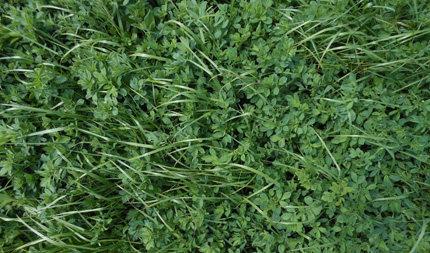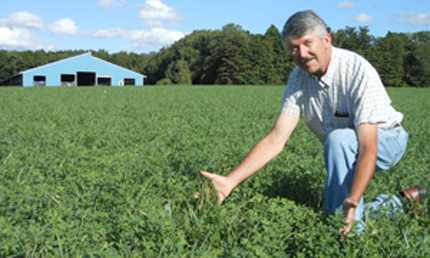Soil Science Society of America
5585 Guilford Road • Madison, WI 53711-5801 • 608-273-8080 • Fax 608-273-2021
www.soils.org
Twitter | Facebook
NEWS RELEASE
Contact: Hanna Jeske, Associate Director of Marketing and Brand Strategy, 608-268-3972, hjeske@sciencesocieties.org
Nutrition information…for cows?
Oct. 26, 2016 - We have it easier than cows. When we want to know how much fat, sodium, or carbohydrates are in the food we are eating, we can usually check the nutrition label on the food’s package. But cows haven't had access to detailed nutrition facts about their forage. Until recently.
 Just as it is important for humans to watch what they eat, it is also important for farmers to watch what their cows are eating. Farmers need to make sure their cows are getting the right amounts of grass and legumes. But when the grass and legumes are grown together, it’s difficult to accurately measure how much of each is in the mixture.
Just as it is important for humans to watch what they eat, it is also important for farmers to watch what their cows are eating. Farmers need to make sure their cows are getting the right amounts of grass and legumes. But when the grass and legumes are grown together, it’s difficult to accurately measure how much of each is in the mixture.
Jerry Cherney, professor of agriculture at Cornell University, says commercial laboratories can only tell if samples are “mostly grass” or “mostly legume.” This type of crude estimate just doesn’t cut it. Farmers need to know what percentage of their mixture is legume and what percentage is grass, so they can make sure their cows are getting a healthy, balanced diet. To more accurately measure the composition of these forage mixtures, researchers have started using near infrared reflectance spectroscopy (NIRS).
Legume and grass molecules vibrate at different frequencies, emitting invisible energy known as infrared. Scientists can use instruments to measure specific near infrared wavelengths. Then, based on the measurements of near infrared, they can determine what percentage of a mixture is legume and what percentage is grass. But even NIRS has its challenges. Mainly, in order to provide accurate measurements, the instruments need to be calibrated.
“In the past, NIRS calibrations were typically instrument-specific. They only worked with the instrument used to develop the calibration,” explains Cherney. So Cherney and his team of researchers worked to develop a single calibration that could be used with many different NIRS instruments.
The research team collected samples from mixed forage fields of alfalfa and grass at 91 sites throughout eight counties in New York. They collected three years of samples to develop their calibration. They collected another year of samples to use later, to verify their calibration. After collecting the samples, they separated the alfalfa from the grass. Then they made over 500 samples that were mixtures with known percentages of alfalfa and grass.
 Next, Cherney worked with Dairy One, a commercial forage testing lab, to scan all of the samples. All of the samples were scanned twice, and then the researchers used three different instruments to analyze the scans. With the analyses from the three instruments, the researchers developed four calibrations -- one for each instrument individually and one for all three instruments combined. Finally, the team tested whether the calibrations worked. They took the final year's samples and combined them into random known proportions. They scanned and analyzed these 98 samples to see if the calibration from the three instruments combined was still accurately measuring the amounts of alfalfa and grass.
Next, Cherney worked with Dairy One, a commercial forage testing lab, to scan all of the samples. All of the samples were scanned twice, and then the researchers used three different instruments to analyze the scans. With the analyses from the three instruments, the researchers developed four calibrations -- one for each instrument individually and one for all three instruments combined. Finally, the team tested whether the calibrations worked. They took the final year's samples and combined them into random known proportions. They scanned and analyzed these 98 samples to see if the calibration from the three instruments combined was still accurately measuring the amounts of alfalfa and grass.
Ultimately, Cherney was able to show that a single calibration can measure alfalfa and grass percentages across instruments. This is great news for farmers, and cows, in the Northeast United States. Farmers now have more accurate information about what’s in the food their cows are eating. But some cows may still be left guessing. “While we’re confident that the calibration should work for sites in the Northeastern USA, we are not sure if it works for Midwestern grown mixtures,” Cherney explained. Calibrations for other parts of the country, like the Midwest, can be developed using the same process Cherney followed in the Northeast.
Read more about Cherney’s work in Crop Science.
Crop Scienceis the flagship journal of the Crop Science Society of America. It is a top international journal in the fields of crop breeding and genetics, crop physiology, and crop production. The journal is a critical outlet for articles describing plant germplasm collections and their use.